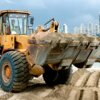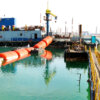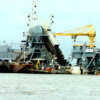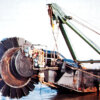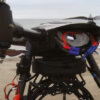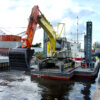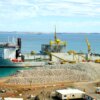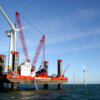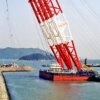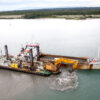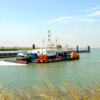Barges (or scows) are used to transport material that has been excavated by mechanical dredgers or to place other equipment at a dredging site.
Hopper barges
Dredged material is loaded onto barges moored close to the dredger. The barges then transport the material to a designated area, where material is unloaded from the barges by being released through the bottom either through cable or hydraulically operated doors, or in the case of split-hulled barges by splitting the barge longitudinally. Sometimes the barges are unloaded using hydraulic pumps or mechanical equipment.
Some barges may be self-propelled, but in many cases they are not. For these barges, tugboats, towboats or tenders are used to tow or push the transport barges to and from the dredging and disposal sites. Barges may transported individually or strapped together in groups depending upon the power of the vessels and sea or waterway conditions such as width and depth of the waterway.
Inland, river barges are often of relatively low draught and narrow to facilitate movement through confined waterways. Sea-going barges are normally much larger and of sturdier construction and are usually self-propelled.
Derrick barges
Derrick barges are flat bottomed vessels with a shallow draught and carry lifting equipment like cranes. These cranes are often integrated into mono-hull pontoon or barge. They are used for lifting large items of equipment on site, particularly during the mobilisation and de-mobilisation stages of a project.
A derrick barge may have an A-frame design, where the whole barge has to be rotated to swivel the lifting gear, or it can have a crane mounted on a turntable so that the turntable swivels.
Crane barges must be large enough to handle the required lifting and remain stable in all sea conditions. A large derrick barge can handle these conditions often better than other working vessels.



